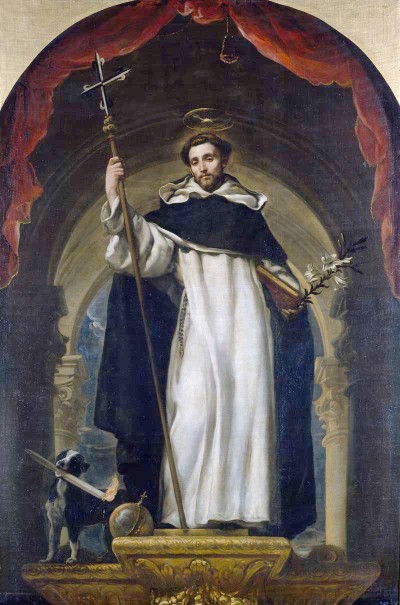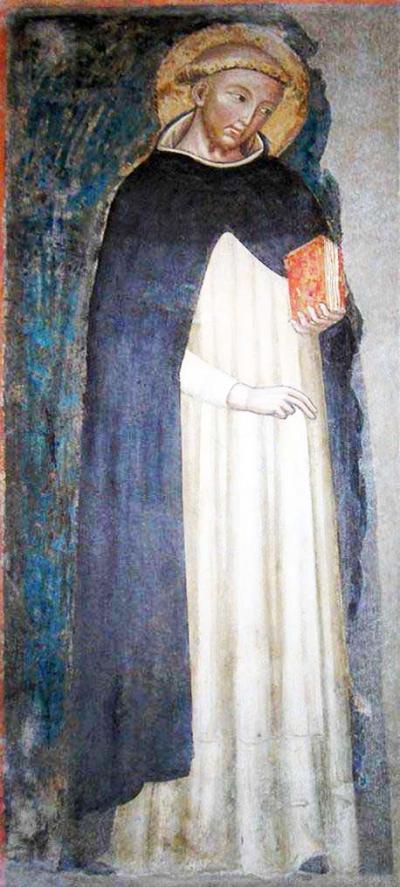Our Founder
Dominic was born between 1171 and 1173 in the Castilian village of Caleruega, the son of Felix de Guzman and Jane of Aza of Spanish nobility. His father was a local lord, but owned little more than range land, a few flocks of sheep, and the manor house and tower which served to guard the land. Jane of Aza was noted for her concern for the poor and was regarded by the local people as a saint. When Dominic was seven his education was put in charge of Jane's brother, a priest, and when he was fourteen he entered the school at Palencia, one of the few higher schools in Spain, where he studied liberal arts and theology. He lived a rather bookish life but during a time of famine sold his books to assist the poor. In 1196, when he was about 24, and ordained a priest, he joined the community of priests serving the cathedral of Osma.
In 1203 Dominic was asked by Bishop Diego of Osma to accompany him on a trip to Denmark. The journey proved the turning point in Dominic's life, opening his eyes to a wider world and its problems. As they passed through southern France they encountered a shocking situation. Christians were abandoning the faith to join the religion of the Cathari (Pure Ones), often called Albigensians from their stronghold at Albi.
One night at an inn in Toulouse, Dominic engaged in a discussion about these strange doctrines with an innkeeper (who was probably a deacon of the Catharist church). Dominic was so moved by meeting this man deluded by the myth of two gods, one good but remote and hidden, and the other evil but creative, that, weary as he must have been after hours on horseback, he sat up all night talking with him and by dawn had won him back to the true God revealed in Jesus Christ.
Dreading the spread of heresy, Dominic began to think about the desperate need to combat this spiritual scourge with gospel truths. He and his bishop were directed by Pope Innocent III to join with Cistercian abbots in a preaching crusade against the heresy.
Dominic centered his preaching around the town of Prouille, where he soon gathered a group of about twelve women converted from the Cathari who wished to continue their ascetic life as Catholic nuns, but needed protection from their families.
Dominic's compassion for people in their spiritual needs fired him with a consuming desire to preach. He was convinced that preaching without prayer would not be effective, and that an authentic witness to the truth of the Gospel demanded a spirit of poverty and penitence.
He took traditional elements in the Church—the apostolic life, priests living in community, regular discipline of the monastic orders, liturgical prayer sung in community, preaching pursued in poverty—and fused them into a balanced unity that enabled his order to meet the needs of his age.
By 1215 he had acquired a small band of companions and established a house in Toulouse, France, that would become the cradle of the Order. In this same year, Dominic accompanied Bishop Fulk of Toulouse to the IV Lateran Council in Rome and, in 1216, gained permission to found an Order of Friars Preachers. Finally in Rome, Dominic seems to have understood the universal meaning of the Order for which he had so long served an apprenticeship: to form a band of brothers to preach the Gospel of Jesus Christ to those who had not heard the Good News, or were swayed by false doctrines.
On returning to Toulouse he held a meeting of his companions, who now numbered about 16, and announced that he would disperse them throughout Europe. He sent them to the university centers of Paris, Spain and Bologna, to receive the scriptural learning necessary for preaching. Through them, the preaching ideal of Dominic inspired students and professors alike to join this new Order.
Over the next 6 years the Order grew to almost 500 friars with 5 provinces and 20 houses. On July 28, 1221, Dominic fell ill and was confined to bed in the Benedictine priory of Monte-Mario. On August 6 he called for one of his companions to hear his confession, and asked to die in one of the houses he had established. Thus, he was carried to the convent of St. Nicholas, where his health continued to decline. As he laid on his deathbed he promised to be of more use to his brethren in death than in life, and commanded his followers to "cherish love, preserve humility, possess only the poverty you have freely chosen." He died on the evening of August 6, not yet fifty years old. Jordan of Saxony was elected as his successor, and at the initiative of Pope Gregory IX Dominic was canonized in 1234.
See B.M. Ashley, OP, The Dominicans, ch. 1, Founder’s Spirit, William A. Hinnebusch, O.P., The Dominicans, A Short History, ch. 1, The Foundation of the Order, and Donald J. Goergen, OP, St. Dominic: The Story of a Preaching Friar. Paulist (2016).


